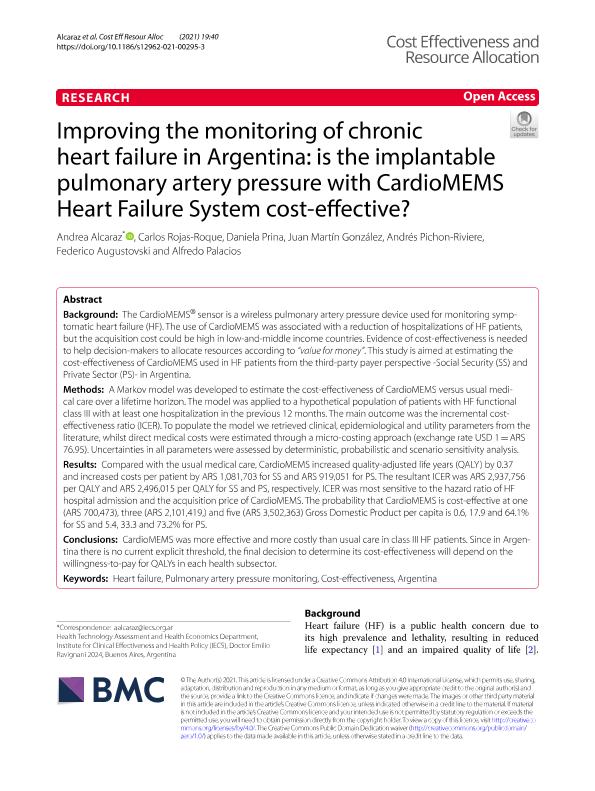Mostrar el registro sencillo del ítem
dc.contributor.author
Alcaraz, Andrea

dc.contributor.author
Rojas Roque, Carlos
dc.contributor.author
Prina, Daniela Luciana

dc.contributor.author
González, Juan Martín
dc.contributor.author
Pichón-riviere, Andres

dc.contributor.author
Augustovski, Federico Ariel

dc.contributor.author
Palacios, Alfredo
dc.date.available
2023-09-26T17:51:03Z
dc.date.issued
2021-12
dc.identifier.citation
Alcaraz, Andrea; Rojas Roque, Carlos; Prina, Daniela Luciana; González, Juan Martín; Pichón-riviere, Andres; et al.; Improving the monitoring of chronic heart failure in Argentina: is the implantable pulmonary artery pressure with CardioMEMS Heart Failure System cost-effective?; BioMed Central; Cost Effectiveness and Resource Allocation; 19; 1; 12-2021; 1-11
dc.identifier.issn
1478-7547
dc.identifier.uri
http://hdl.handle.net/11336/213117
dc.description.abstract
Background: The CardioMEMS® sensor is a wireless pulmonary artery pressure device used for monitoring symptomatic heart failure (HF). The use of CardioMEMS was associated with a reduction of hospitalizations of HF patients, but the acquisition cost could be high in low-and-middle income countries. Evidence of cost-effectiveness is needed to help decision-makers to allocate resources according to “value for money”. This study is aimed at estimating the cost-effectiveness of CardioMEMS used in HF patients from the third-party payer perspective -Social Security (SS) and Private Sector (PS)- in Argentina. Methods: A Markov model was developed to estimate the cost-effectiveness of CardioMEMS versus usual medical care over a lifetime horizon. The model was applied to a hypothetical population of patients with HF functional class III with at least one hospitalization in the previous 12 months. The main outcome was the incremental cost-effectiveness ratio (ICER). To populate the model we retrieved clinical, epidemiological and utility parameters from the literature, whilst direct medical costs were estimated through a micro-costing approach (exchange rate USD 1 = ARS 76.95). Uncertainties in all parameters were assessed by deterministic, probabilistic and scenario sensitivity analysis. Results: Compared with the usual medical care, CardioMEMS increased quality-adjusted life years (QALY) by 0.37 and increased costs per patient by ARS 1,081,703 for SS and ARS 919,051 for PS. The resultant ICER was ARS 2,937,756 per QALY and ARS 2,496,015 per QALY for SS and PS, respectively. ICER was most sensitive to the hazard ratio of HF hospital admission and the acquisition price of CardioMEMS. The probability that CardioMEMS is cost-effective at one (ARS 700,473), three (ARS 2,101,419,) and five (ARS 3,502,363) Gross Domestic Product per capita is 0.6, 17.9 and 64.1% for SS and 5.4, 33.3 and 73.2% for PS. Conclusions: CardioMEMS was more effective and more costly than usual care in class III HF patients. Since in Argentina there is no current explicit threshold, the final decision to determine its cost-effectiveness will depend on the willingness-to-pay for QALYs in each health subsector.
dc.format
application/pdf
dc.language.iso
eng
dc.publisher
BioMed Central

dc.rights
info:eu-repo/semantics/openAccess
dc.rights.uri
https://creativecommons.org/licenses/by/2.5/ar/
dc.subject
ARGENTINA
dc.subject
COST-EFFECTIVENESS
dc.subject
HEART FAILURE
dc.subject
PULMONARY ARTERY PRESSURE MONITORING
dc.subject.classification
Otras Ciencias de la Salud

dc.subject.classification
Ciencias de la Salud

dc.subject.classification
CIENCIAS MÉDICAS Y DE LA SALUD

dc.title
Improving the monitoring of chronic heart failure in Argentina: is the implantable pulmonary artery pressure with CardioMEMS Heart Failure System cost-effective?
dc.type
info:eu-repo/semantics/article
dc.type
info:ar-repo/semantics/artículo
dc.type
info:eu-repo/semantics/publishedVersion
dc.date.updated
2023-09-19T13:12:15Z
dc.journal.volume
19
dc.journal.number
1
dc.journal.pagination
1-11
dc.journal.pais
Estados Unidos

dc.description.fil
Fil: Alcaraz, Andrea. Instituto de Efectividad Clínica y Sanitaria; Argentina
dc.description.fil
Fil: Rojas Roque, Carlos. Instituto de Efectividad Clínica y Sanitaria; Argentina
dc.description.fil
Fil: Prina, Daniela Luciana. Instituto de Efectividad Clínica y Sanitaria; Argentina
dc.description.fil
Fil: González, Juan Martín. Instituto de Efectividad Clínica y Sanitaria; Argentina
dc.description.fil
Fil: Pichón-riviere, Andres. Consejo Nacional de Investigaciones Científicas y Técnicas. Oficina de Coordinación Administrativa Parque Centenario. Centro de Investigaciones en Epidemiología y Salud Pública. Instituto de Efectividad Clínica y Sanitaria. Centro de Investigaciones en Epidemiología y Salud Pública; Argentina
dc.description.fil
Fil: Augustovski, Federico Ariel. Consejo Nacional de Investigaciones Científicas y Técnicas. Oficina de Coordinación Administrativa Parque Centenario. Centro de Investigaciones en Epidemiología y Salud Pública. Instituto de Efectividad Clínica y Sanitaria. Centro de Investigaciones en Epidemiología y Salud Pública; Argentina
dc.description.fil
Fil: Palacios, Alfredo. Instituto de Efectividad Clínica y Sanitaria; Argentina
dc.journal.title
Cost Effectiveness and Resource Allocation
dc.relation.alternativeid
info:eu-repo/semantics/altIdentifier/url/https://resource-allocation.biomedcentral.com/articles/10.1186/s12962-021-00295-3
dc.relation.alternativeid
info:eu-repo/semantics/altIdentifier/doi/http://dx.doi.org/10.1186/s12962-021-00295-3
Archivos asociados
